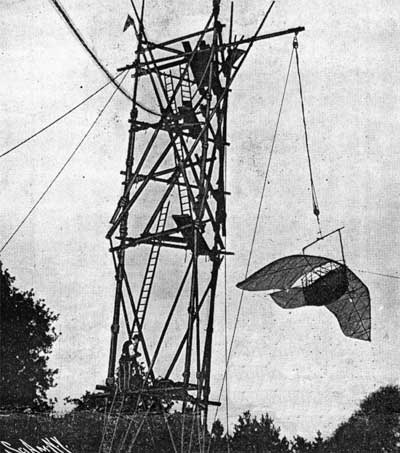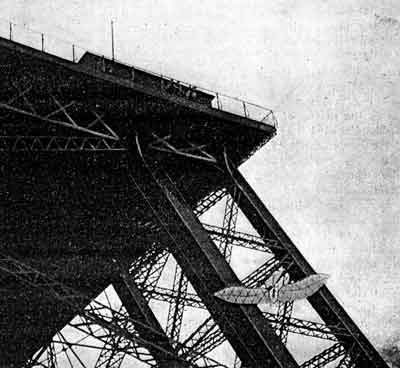

The present writer's experience in experiments with aeroplanes has demonstrated to his satisfaction that glides with fixed passive surfaces of sufficient area (175 square feet) according to Lilienthal, Pilcher, and Cham ber's dimensions, are an admirable means of courting sudden death. Aeroplane fixed surfaces present such an enormous "sail area," and the wind is so notoriously. capricious, that to endeavor to reduce flight to perfection, as in the eagle, condor, albatross, and other "gliders," is to attempt the impossible. Why? For the simple reason that we are attempting an advanced stage of progress before we have attained elementary flight i. e., initial extended flights at will. As a forcible illustration of the vagaries and force of the wind, the writer recently, at the top of the Watkin tower, Wembly Park, 160 feet high, in carrying an artificial wing ten feet long by four feet wide, was thrown sprawling on the platform by an unexpected gust.

Fig. 1.--Two Pettigrew
Wings.
Shall man ever reproduce, by his method, "the way of an eagle in the air"? Decidedly, provided he departs from his present tendency toward the aeroplane, and constructs his dynamic aerial ship more on practical lines and in accordance with natural laws as embodied in the bird, bat, and insect. Artificial flight resolves itself into reproducing Nature and her principles by man's method and ingenuity. We pave abundant testimony by Pettigrew's researchers that the artificially-constructed wing becomes in action a powerful propeller, sustainer, and aeroplane, increasing in efficiency with the speed at which it is driven. Screws, moreover, opposing a slanting plane, will create an ascensive movement, or horizontally, will increase the disposable weight apart from the motor and apparatus proportionately as speed increases, but will not retard descent, as in the artificial wing. Herein the wing has an inherent advantage, theoretically, over the screw, but the writer considers in practice the screw far more practical, basing this remark on his own experiments with full-sized apparatus.

Fig. 2.--Attempts
Were Made With and Against the Wind with the Apparatus Held Perfectly
Horizontal.
Nothing is better established than that theory and practice will not agree in aerial experimentation when we come to test our apparatus. Such is the erratic behavior of the wind that it entirely upsets our calculations, besides our machines. In Fig. 1 two Pettigrew type of wings are shown (somewhat hastily put together for photographing only), to test their efficiency when actually in the air. The results were extremely disappointing the apparatus in many trial flights, and reducing and adjustment of weights, refusing to "glide," even its earliest trials before they began to show signs of considerable usage. Attempts were made with and against the wind, with the apparatus held perfectly horizontal (Fig. 2), but though the height of the specially erected staging is 60 feet, results. and poor results at that, could be obtained only by increasing the surface which, for flapping flight, of course, was inadmissible. The weight of the second model, Fig. 2, was approximately 250 pounds, with aeronaut and contemplated motor of 6 horse-power, being 22 feet tip to tip, with a "tail" five feet long and three feet across. In beating the air the anterior margin of the wings, being heavier and semi-rigid, created a tendency to pitch the machine forward and downward; indeed, it was recognized by the writer that the Pettigrew form of wing, as advocated, although suitable for laboratory experiments, is quite unsuitable for full-sized apparatus in the air itself, the power transferred to the front edge being wrongly applied. The last experiment with this type of wing is shown in Fig. 3, when the apparatus launched from the top of the Watkin tower, 160 feet high, while swaying in a 40-mile wind similar to a bird in strong cross currents, retained its balance perfectly, reaching terra firma though but a short distance away, on a perfectly level keel. A previous trial with the. weight more forward from the center caused the apparatus to plunge headlong. Sufficient experience, however, with the full-sized models, has justified the construction of two new winged apparatus on new and more advanced lines, more in accordance with Nature's plans. The first is for individual or one-man flight, for use with a gasoline engine of 6 horse-power, the wings being deeply concave with semi-rigid anterior margins, and graduating posterior edges. One pair only will be employed, each 8 feet long by 6 feet wide, with a fan-shaped tail at the rear. It is estimated at 240 reciprocating strokes per minute the machine will be propelled in an ascensional and forward flight of at least 180 feet per minute, or 3 feet per second. The second apparatus, on the same lines, has eight wings measuring 18 feet from tip to tip, flapping alternately to conserve weight and driving power. It will be tested with a gasoline motor of 50 horse-power. A third machine, nearly completed, is now on the top of the Watkin tower (Fig. 3), Wembly Park, England, and is the favorite machine of the writer. It is 70 feet long, 10 feet wide at the center, and will be elevated by thirty ascensional screws 5 feet diameter, with a fine pitch. There are four propulsive screws seven feet each in diameter, capable of revolving at high speed, driven i in opposite directions The whole machine will be driven by a gasoline engine of 100 horse-power weighing 400 pounds.

Fig. 3.--The 160-Foot
Tower from Which the Apparatus Was Launched.
Originally appeared in Scientific American, 93, December 16, 1905, p. 481.
sbck/htgb